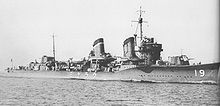

| Action of 11 January 1944 | |||||||
|---|---|---|---|---|---|---|---|
| Part of the Pacific theatre of the Second World War | |||||||
 Plan of the Japanese light cruiser Kuma | |||||||
| |||||||
| Belligerents | |||||||
|
|
| ||||||
| Commanders and leaders | |||||||
|
|
| ||||||
| Strength | |||||||
| Submarine Tally-Ho |
Light cruiser Kuma Destroyer Uranami | ||||||
| Casualties and losses | |||||||
| None |
Kuma sunk 138 killed | ||||||

The action of 11 January 1944 was a minor naval action that resulted in the sinking of the light cruiser Kuma of the Imperial Japanese Navy by the British Royal Navy submarine HMS Tally-Ho. Kuma was being escorted by the destroyer Uranami about 10 nmi (12 mi; 19 km) north-west of Penang, Malaya.
Tally-Ho was patrolling from her base at Trincomalee, Ceylon searching for Japanese vessels and on 9 January, sighted the Japanese light cruiser Kuma off Penang. Kuma was on anti-submarine warfare exercises. She was flanked by destroyers and Tally-Ho could not get within range. She was able to plot the Japanese's route in and out of Penang and to take up a suitable position to intercept the cruiser.

On the morning of 11 January, Tally-Ho's commander, Leslie Bennington, spotted a Mitsubishi F1M2 Pete floatplane flying westwards along the route on which the cruiser that had been sighted on 9 January was to be expected. It was felt that this heralded the approach of the cruiser. Just before 09:00, the officer of the watch sighted the masts of the cruiser on the port bow. Kuma had a destroyer—Uranami—as an escort. Whilst 10 nmi (12 mi; 19 km) north west of Penang, at midday, Bennington fired a seven-torpedo salvo from 1,900 yd (1,700 m). Kumas's lookouts soon spotted the torpedoes' wakes, and Captain Sugino shifted his rudder hard over. Kuma was hit starboard aft by two torpedoes.[2] Bennington decided to head toward the shallows along the shore. The destroyer Uranami counterattacked with 18 depth charges, but all missed the submarine. A fire raged on board the Kuma and she soon began to sink by the stern. As she sank, her own depth charges detonated. Uranami then picked up the survivors, including Captain Sugino, while 138 crewmen were lost.[3]
After his success, Bennington managed to slip away and returned to Trincomalee.